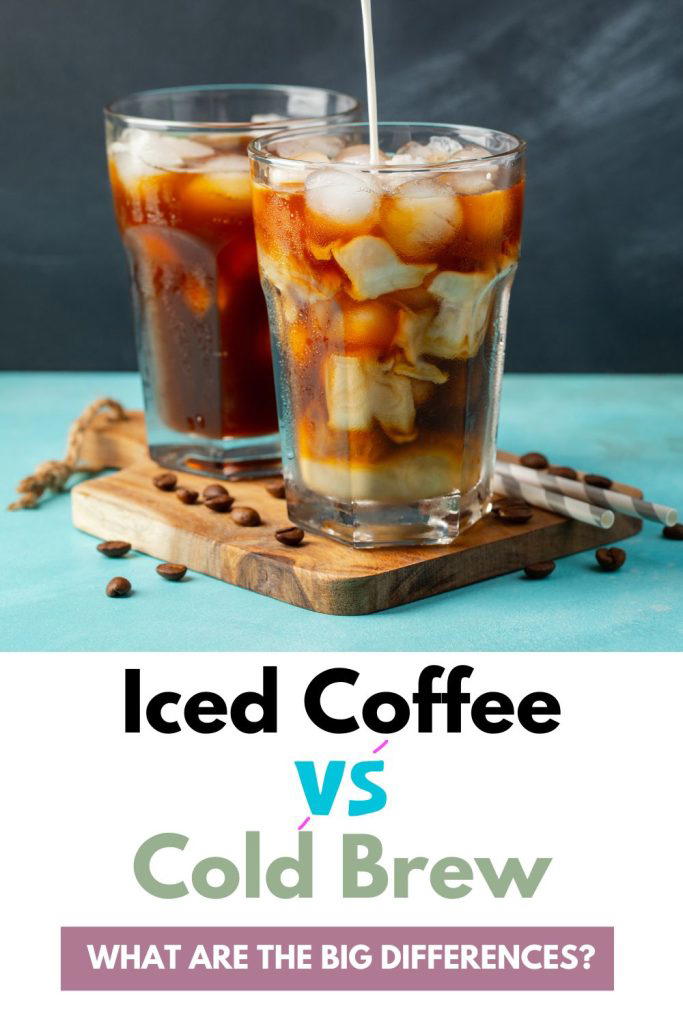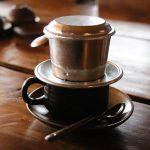Most people probably think of a steaming hot mug when they think of coffee. But regular hot coffee is becoming less popular, especially in the hot summer months, thanks to two other ways to enjoy a brew: cold brew and iced coffee. In this article, we explore the differences between iced coffee and cold brew, including how each is made.
There are several differences between iced coffee and cold brew coffee, but the most prominent are the taste, strength, brewing process, the mixture of ingredients, and aroma that welcomes you and wakes up your taste buds.
How to Make Iced Coffee
Iced coffee uses regular ground coffee brewed in hot water, so the strong acidic notes in the coffee when you first brew it are still there when you cool it. After brewing, the drip coffee is cooled, diluted with water, and served chilled with ice. To enhance the coffee taste further, add sugar or cream.
Iced coffee is easy to make and is the go-to option for people who prefer timeless and strong coffee. Regular iced coffee has a bold flavor due to its bitterness because it uses hot water to draw out the flavors and caffeine from the coffee beans, embracing a brighter, more powerful taste.
How to Make Cold Brew Coffee
Cold brew is a distinctive brewing process that involves immersing roughly ground coffee beans in frigid water for a protracted time span.
Coffee-to-water proportion: An ideal starting point for the coffee-to-water ratio is 1:4 or 1:5. In other words, if you employ 1 cup of coffee grounds, you would want to add 4 to 5 cups of water. It is plausible to modify this ratio according to personal preferences, although a greater ratio would typically generate a bolder coffee flavor.
Immersion duration: The ideal immersion duration for cold brew normally lasts anywhere from 12 to 24 hours, contingent on your desired strength of coffee. It would be prudent to test various immersion durations to ascertain which one works optimally for you.
Brewing approaches: There are several methods to brew cold brew coffee, such as the immersion method and the slow drip method.
The immersion method involves submerging the coffee grounds in cold water for the desired period of time, then filtering out the grounds. This process can be carried out with a French press, a mason jar, or any other container with a cap.
The slow drip method involves gradually dripping frigid water through a stratum of coffee grounds over a long period, generally 6 to 12 hours. This process mandates a specialized slow drip coffee maker and is commonly employed by coffee shops and professional baristas.
This coffee has a more standard flavor profile because people like its smoothness, sweetness, thick and creamy texture, and lack of bitterness that comes from the brewing process. Since the coffee beans are never warmed, the more acidic flavors are not extracted, offering a smooth and rich taste.

Iced Coffee vs Cold Brew
Strength (caffeine content)
When it comes to cold brew vs iced coffee, the significant difference is the brewing process. The hot water poured over the coffee has normal strength, but it diminishes when it hits the ice, becoming watery and moderately bitter.
Iced coffee has up to 40 mg of caffeine (regular strength) and, thus, is cheaper than cold brew coffee, which has as much as 200mg of caffeine in a 16oz cup. On the other hand, cold brew coffee uses double the amount of coffee grounds to get that much caffeine.
Cost
Traditional iced coffee is much cheaper at local coffee shops due to its simple and easy brewing process. In addition, the process of making this coffee is fast. In contrast, cold brew coffee is twice the price of iced coffee due to the amount of beans used, the caffeine content, and the long brewing process.
Flavor
Cold brew coffee is a concentrated drink that has recently gained popularity among coffee drinkers. It is the ideal pick-me-up beverage all year-round, but especially in warm summer months.
A unique cold brew coffee that keeps popping up is Nitro coffee. Nitro cold brew coffee is infused with nitrogen gas to give a delightful texture and taste. It’s been lauded as exceptional by coffee enthusiasts and is an enjoyable alternative.
Now, let’s answer the age-old question, which one is better? Both coffees offer you the uniqueness and delicious taste you need, despite their differences.

Why Most People Love Cold Brew Coffee
Most people in the US prefer cold brews to regular iced coffee. Cold brew is the better option for them because it is 65 to 67% less acidic and is excellent for those with gastric issues. Thus, it enhances your rate of metabolism by 11%, which feels better for the digestive system.
In addition, it was found that, along with the significant health benefits, the coffee tastes sweeter and is thicker in texture. In addition, it has a slow brewing method and a consistent room temperature.
Why Some People Prefer Iced Coffee
On the contrary, people prefer iced coffee because it has a strong taste and wine-like acidity when chilled. Plus, it is a lot easier to make compared to the extended brewing process of cold brew.
However, some coffee shops have found a new technique for brewing this type of coffee. By brewing hot coffee and then pouring it directly into the ice, you conserve all the natural aromas of the coffee, and it retains much more flavor, much to the joy of coffee lovers everywhere. Alternatively, you can make coffee ice cubes to help your iced coffee keep its flavor. With coffee ice cubes, your drink won’t be watered down as the ice melts, so it stays just as strong.
How to choose? Iced Coffee or Cold Brew Coffee
You may be wondering how to choose between iced coffee and cold brew now that you understand the differences. Here are some other aspects to think about:
Preferences for the Seasons
One of the best aspects of iced coffee and cold brew is that they are both quite adaptable, which means they can be drank all year. Yet, some people enjoy iced coffee in the summer, whereas cold brew may be more appropriate in the cooler months. Consider the season and the type of coffee you prefer at that time of year.
Bravery and Strength
If you enjoy a powerful and strong flavour profile in your coffee, iced coffee may be the ideal option for you. Iced coffee is popular among coffee connoisseurs because of its rich flavour and aroma. Cold brew coffee, on the other hand, may be the way to go if you prefer a milder taste and a smoother finish.
Brewing Procedure
Another thing to think about is the brewing procedure. If you prefer preparing coffee at home, you should think about the convenience of preparation. Iced coffee can be made in a variety of ways, including drip, pour-over, and French press. Cold brew, on the other hand, involves more preparation and time, which may not be suited for individuals looking for a quick and easy caffeine hit.
Health Advantages
Iced coffee and cold brew both have significant health benefits, including improved cognitive function, higher energy, and a lower risk of chronic diseases. It is crucial to note, however, that iced coffee may contain more acid, which may cause stomach pain in certain people. If you have stomach troubles, cold brew may be a better option due to its lower acidity level.
Cost
The price of iced coffee and cold brew varies based on where you purchase it. Cold brew coffee is typically more expensive than iced coffee because it requires more coffee grounds and a longer steeping time. Making iced coffee or cold brew at home can save you money in the long term if you’re on a budget.
Conclusion
To sum it up, both of these cold coffee drinks are perfect in their own way and a great alternative to hot coffee, especially in the summer. The differences lie in the brewing process. Cold brew offers more health benefits, but it is a much more involved process and will cost a little more money.
Iced coffee is a lot easier to make and more affordable, and it does the job when you need a pick-me-up on a hot day. If you want to try something extra special, go for a Nitro cold brew. There are many ways to enjoy a cold coffee drink. Find the one that best suits you.
Frequently Asked Questions
Does iced coffee have more caffeine than cold brew?
Typically, a cold brew will have more caffeine than iced coffee. This is because cold brew is often made with a higher coffee-to-water ratio, leading to a more intense, caffeinated brew.
Why is cold brew more expensive than iced coffee?
Cold brew tends to be pricier than iced coffee because of the labor required to make it. Making cold brew is a long, time-intensive process. It also requires more coffee beans to make than iced coffee, contributing to a higher price point.
Can I make cold brew with espresso beans?
Yes, you can use espresso beans to create cold brew! You just follow the same process you would when making cold brew with coffee beans.
How long does cold brew coffee last?
Cold brew coffee can last up to two weeks when stored in an airtight container in the refrigerator. However, the flavor may begin to degrade after a few days, so it is best to consume it within the first week.
Can I add milk or cream to my iced coffee or cold brew?
Yes, you can add milk or cream to both iced coffee and cold brew. Many people prefer to add milk or cream to their coffee to enhance the flavor and texture.
Which is more expensive, iced coffee, or cold brew?
The cost of iced coffee and cold brew can vary depending on where you buy it. Typically, cold brew is more expensive because it requires more coffee grounds and a longer steeping process.
Pin Later







